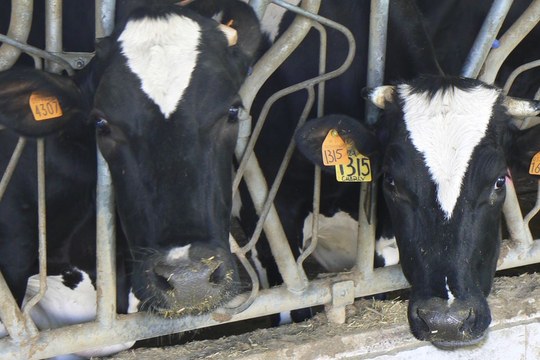
The Project
One SUStainability vision in Dairy farms: a big Data approach for a perspective Decision-making (SUS3D)
The concept
To date, there is no method available that can integrate information from sustainability analysis with information from wellbeing and health assessments.
Future goal
The sustainable development of animal-derived products is one of the greatest challenges for next years, due to the increasing pressure on the livestock sector to meet the growing demand of a growing population, but at the same time reducing the resource requirements and the environmental impacts, safeguarding animal welfare.
Present strategies
The environmental, social, and economic sustainability of livestock farms are widely acknowledged in the European Green Deal and in the Italian PNRR (Piano Nazionale di Ripresa e Resilienza) where the transition to sustainable food production is recognised as a key element for the future development of the planet.
The need for an innovative tool
The motivation stimulating the main idea of the project is that, a method or a tool able to integrate the information deriving from the analysis of the three sustainability dimensions with the information deriving from welfare and health assessments, is not available.
The general objective
Objective of the project is to define a tool based on a big data approach integrating the sustainability assessment with the welfare measures on dairy cow farms for a perspective decision-making.
A sustainable livestock sector
Within the development of a sustainable food system, animal production plays a debated role, thus its sustainable transition is particularly difficult and controversial. Therefore, the environmental, social and economic sustainability of livestock farming benchmarks are nowadays widely acknowledged in the European Green Deal (European Commission, 2022) with the Farm to Fork strategy 2020-2030 and also in the Italian Recovery Plan (PNRR Piano Nazionale di Ripresa e Resilienza, 2022), where the transition to sustainable food production is recognised as a key element for the future development of the planet.
Livestock farming contributes to social sustainability through food provision, employment, landscape and agricultural heritage maintenance (European Commission, 2020). In addition, it can contribute to economic sustainability, which can be described as the economic viability of agricultural systems and can be evaluated through profitability, self-sufficiency of inputs, diversification, and durability (family and employee labour costs). On the other hand, the livestock sector can have a negative impact on the environment through the depletion of the resources (e.g. biotic, water, energy and also land-use change) and the production of physical flows (e.g. nutrients and emissions to air, soil and inland water) that can affect biodiversity, human health and ecosystems.
Strong efforts are currently being made to convert livestock farms to more sustainable management, but there is still a long way to go.
How can we effectively assess farms sustainability?
Sustainable development is one of the greatest challenges of our time as also underlined by the United Nations’ Sustainable Development Goals (SDGs), which involve several aspects of our lives in economic, social and environmental issues. Sustainable development is a complex topic, defined by the Brundtland Report as “that development that meets the needs of the present without compromising the ability of future generations to meet their own needs”.
In the procedures tools nowadays used to assess the sustainability of farms, animal health and welfare are usually neglected or not organically integrated despite the numerous validated protocols existing their assessment.
The method
The novel method will have a multidisciplinary and integrated approach to assess the overall farm sustainability in order to identify criticalities and actions to improve the dairy cow sector.
"One Sustainability"
This method will encompass all the dimensions (environmental, economic and social) and ecosystems (environment, animals, humans) of sustainability with a “One Sustainability” approach.
The overall sustainability indices that will emerge from this project will help to improve the sustainability of the livestock sector and make the first step of the production chain more efficient and less impactful thanks to the long term perspective driving the decision-making process in daily management.
Practical approach
The project is subdivided into 7 Workpackages (WP), each one associated to the goals reported below:
1) management of the project (WP1);
2) collection of data of the factors affecting the sustainability of dairy farms (WP2, WP3 and WP4);
3) analysis of the data collected in WP2, WP3 and WP4 using existing and well-known tools for each sustainability dimension (WP5);
4) evaluation of the relations between the different sustainability indicators within and between the different ecosystems (WP6);
5) development of the pipeline of a multidisciplinary tool implementing a long term sustainable perspective (WP6);
6) identifying the target actions to introduce in order to improve the overall sustainability of the farms (WP6);
7) dissemination of the results (WP7)
The structure of the project
Each one of the main workpackages (WP) is associated to the achievement of specific goals
WP2: Housing and Management
Objectives: define the aspects relating to the housing conditions and the management of the herd that can affect and influence environmental sustainability of the farm, welfare and productivity of the animals and welfare of the workers.
WP3: Animal welfare and health
Objectives: assess animal welfare and health in the dairy farms involved in the project with a common approach. These could be influenced by housing and management and could have an impact on economic, environmental and social sustainability.
WP4: Economic, Social and Ethical indicators
Objectives: to collect data related with social and economic sustainability of the dairy farms involved in the project and to survey the ethical acceptability of dairy farming to consumers.
WP5: One sustainability approach
Objectives: to analyse the data collected in WP2, WP3 and WP4 using existing and well-known tools for each sustainability dimension.
WP6: Better actions
Objectives: The advanced integrated models developed in this WP will integrate the results of the environmental assessment with animal-related information (welfare and health) and with economic, social and ethical results.